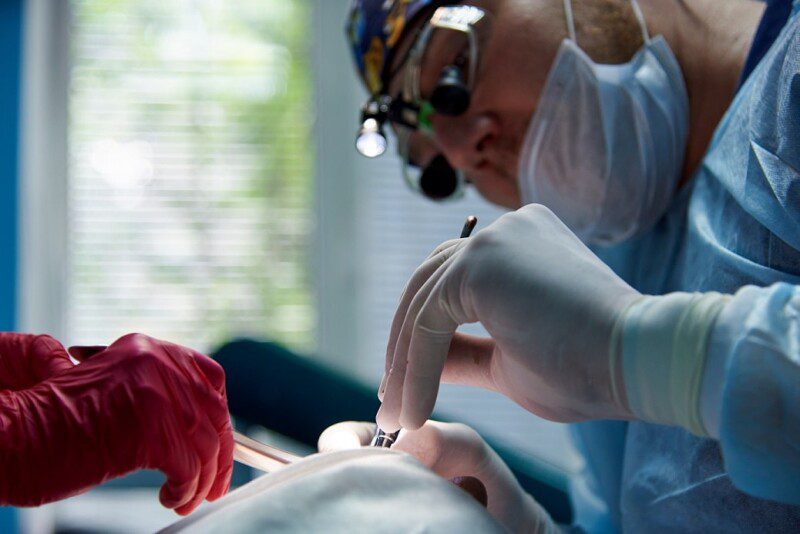Endodontic Therapy
A root canal is one of the most common dental procedures performed, well over 14 million every year. This simple treatment can save your natural teeth and prevent the need of dental implants or bridges.
Symptoms that mean you might need a Root Canal
Severe pain while chewing or biting
Pimples on the gums
A chipped or cracked tooth
Lingering sensitivity to hot or cold, even after the sensation has been removed
Swollen or tender gums
Deep decay or darkening of the gums

Symptoms that mean you might need a Root Canal
Severe pain while chewing or biting
Pimples on the gums
A chipped or cracked tooth
Lingering sensitivity to hot or cold, even after the sensation has been removed
Swollen or tender gums
Deep decay or darkening of the gums


Root Canal Explained
At the center of your tooth is pulp. Pulp is a collection of blood vessels that help to build the surrounding tooth. Infection of the pulp can be caused by trauma to the tooth, deep decay, cracks and chips, or repeated dental procedures. Symptoms of the infection can be identified as visible injury or swelling of the soft tissue, sensitivity to temperature or pain in the tooth and gums.
If you experience any of these symptoms, your dentist will most likely recommend non-surgical treatment to eliminate the diseased pulp. This injured pulp is removed and the root canal system is thoroughly cleaned and sealed. This therapy usually involves conscious sedation and may be completed in one or more visits depending on the treatment required. If your tooth is not amenable to endodontic treatment or the chance of success is unfavorable, you will be informed at the time of consultation or when a complication becomes evident during or after treatment. We use local anesthesia to eliminate discomfort. In addition, we will provide nitrous oxide analgesia, if indicated. You will be able to drive home after your treatment, and you probably will be comfortable returning to your normal routine.



Root Canal Explained
At the center of your tooth is pulp. Pulp is a collection of blood vessels that help to build the surrounding tooth. Infection of the pulp can be caused by trauma to the tooth, deep decay, cracks and chips, or repeated dental procedures. Symptoms of the infection can be identified as visible injury or swelling of the soft tissue, sensitivity to temperature or pain in the tooth and gums.
If you experience any of these symptoms, your dentist will most likely recommend non-surgical treatment to eliminate the diseased pulp. This injured pulp is removed and the root canal system is thoroughly cleaned and sealed. This therapy usually involves conscious sedation and may be completed in one or more visits depending on the treatment required. If your tooth is not amenable to endodontic treatment or the chance of success is unfavorable, you will be informed at the time of consultation or when a complication becomes evident during or after treatment. We use local anesthesia to eliminate discomfort. In addition, we will provide nitrous oxide analgesia, if indicated. You will be able to drive home after your treatment, and you probably will be comfortable returning to your normal routine.
Advantages Of Saving Your Natual Tooth
Efficient chewing
Normal biting force and sensation
Natural appearance
Protects other teeth from excessive wear or strain



Advantages Of Saving Your Natual Tooth
Efficient chewing
Normal biting force and sensation
Natural appearance
Protects other teeth from excessive wear or strain






After Treatment
When your root canal therapy has been completed, a record of your treatment will be sent to your restorative dentist. You should contact their office for a follow-up restoration within 30 days of completion at our office. Your restorative dentist will decide on what type of restoration is necessary to protect your tooth. It is rare for endodontic patients to experience complications after routine endodontic treatment or microsurgery. If a problem does occur, however, we are available at all times to respond. To prevent further decay, continue to practice good dental hygiene.



After Treatment
When your root canal therapy has been completed, a record of your treatment will be sent to your restorative dentist. You should contact their office for a follow-up restoration within 30 days of completion at our office. Your restorative dentist will decide on what type of restoration is necessary to protect your tooth. It is rare for endodontic patients to experience complications after routine endodontic treatment or microsurgery. If a problem does occur, however, we are available at all times to respond. To prevent further decay, continue to practice good dental hygiene.
Costs
Don’t get a tooth pulled because you think it’s easier or more cost-effective. Missing teeth can cause other teeth to shift, affect your ability to properly chew, and ruin your smile. Tooth extraction often is more painful than the infection itself, and replacing an extracted tooth with an artificial one requires additional dental visits that can quickly add up.
The cost associated with this procedure can vary depending on factors such as the severity of damage to the affected tooth and which tooth is affected. In general, endodontic treatment is much less expensive than tooth removal and replacement with an artificial tooth.



Costs
Don’t get a tooth pulled because you think it’s easier or more cost-effective. Missing teeth can cause other teeth to shift, affect your ability to properly chew, and ruin your smile. Tooth extraction often is more painful than the infection itself, and replacing an extracted tooth with an artificial one requires additional dental visits that can quickly add up.
The cost associated with this procedure can vary depending on factors such as the severity of damage to the affected tooth and which tooth is affected. In general, endodontic treatment is much less expensive than tooth removal and replacement with an artificial tooth.



Myths About Root Canals and Root Canal Pain
There are many misconceptions surrounding root canal (endodontic) treatment and whether patients experience root canal pain. The American Association of Endodontists wants you to have accurate information. As always, when considering any medical procedure, you should get as much information as you can about all of your options. Your dentist or endodontist can answer many of your questions, and if you still have concerns, it is often wise to seek a second opinion.
Truth—Root canal treatment doesn’t cause pain, it relieves it.
The perception of root canals being painful began decades ago but with modern technologies and anesthetics, root canal treatment today is no more uncomfortable than having a filling placed. In fact, a recent survey showed that patients who have experienced root canal treatment are six times more likely to describe it as “painless” than patients who have not had root canal treatment.
Most patients see their dentist or endodontist when they have a severe toothache. The toothache can be caused by damaged tissues in the tooth. Root canal treatment removes this damaged tissue from the tooth, thereby relieving the pain you feel.
The myth: Patients searching the Internet for information on root canals may find sites claiming that teeth receiving root canal (endodontic) treatment contribute to the occurrence of illness and disease in the body. This false claim is based on long-debunked and poorly designed research performed nearly a century ago by Dr. Weston A. Price, at a time before medicine understood the causes of many diseases.
In the 1920s, Dr. Price advocated tooth extraction—the most traumatic dental procedure—over endodontic treatment. This resulted in a frightening era of tooth extraction both for treatment of systemic disease and as a prophylactic measure against future illness.
The truth: There is no valid, scientific evidence linking root canal-treated teeth and disease elsewhere in the body. A root canal is a safe and effective procedure. When a severe infection in a tooth requires endodontic treatment, that treatment is designed to eliminate bacteria from the infected root canal, prevent reinfection of the tooth and save the natural tooth.
- The presence of bacteria in teeth and the mouth has been an accepted fact for many years. But the presence of bacteria does not constitute “infection” and is not necessarily a threat to a person’s health. Bacteria are present in the mouth and teeth at all times, even in teeth that have never had a cavity or other trauma. Research shows that the healthy immune system takes care of bacteria in a matter of minutes.
- Tooth extraction is a traumatic procedure and is known to cause a significantly higher incidence of bacteria entering the bloodstream; endodontic treatment confined to the root canal system produces much less trauma and a much lower incidence and magnitude of bacteria entering the blood stream.
- There is no adequate replacement for the natural tooth – it should be saved whenever possible. Root canal treatment, along with appropriate restoration, is a cost effective way to treat infected teeth because it is usually less expensive than extraction and placement of an implant. In most cases, endodontic treatment allows patients to keep their natural teeth for a lifetime.
But what about Dr. Price? This is a good example of how the Internet can give new life to long-dispelled theories. Believe it or not, the misinformation about roots canals that is found on the Internet is still based on Dr. Price’s century-old, discredited research. Dr. Price’s research techniques were criticized at the time they were published, and by the early 1930s, a number of well-designed studies using more modern research techniques discredited his findings. In 1951, the Journal of the American Dental Association took the extraordinary step of publishing a special edition reviewing the scientific literature and shifted the standard of practice back to endodontic treatment for teeth with non-vital pulp in instances where the tooth could be saved. The JADA reviewed Dr. Price’s research techniques from the 1920s and noted that they lacked many aspects of modern scientific research, including absence of proper control groups and induction of excessive doses of bacteria.
As recently as 2013, research published in JAMA Otolaryngology—Head & Neck Surgery, found that patients with multiple endodontic treatments had a reduced risk of cancer.
Truth—Saving your natural teeth, if possible, is the very best option.
Nothing can completely replace your natural tooth. An artificial tooth can sometimes cause you to avoid certain foods. Keeping your own teeth is important so that you can continue to enjoy the wide variety of foods necessary to maintain the proper nutrient balance in your diet. If your dentist recommends extraction, ask whether root canal treatment is an option.
Endodontic treatment, along with appropriate restoration, is a cost-effective way to treat teeth with damaged pulp and is usually less expensive than extraction and placement of a bridge or an implant.
Endodontic treatment also has a very high success rate. Many root canal-treated teeth last a lifetime.
Placement of a bridge or an implant will require significantly more time in treatment and may result in further procedures to adjacent teeth and supporting tissues.
Millions of healthy endodontically treated teeth serve patients all over the world, years and years after treatment. Those healthy teeth are helping patients chew efficiently, maintain the natural appearance of their smiles and enhance their enjoyment of life. Through endodontic treatment, endodontists and dentists worldwide enable patients to keep their natural teeth for a lifetime.
Endodontic References
- Easlick K: An Evaluation of the Effect of Dental Foci of Infection on Health. JADA 42:615-686, 694-697, June1951.
- Grossman L: Root Canal Therapy. 4th edition, Lea & Febiger, Philadelphia, 15-40, 1955.
- Grossman L: Focal Infection: Are Oral Foci of Infection Related to Systemic Disease? Dent ClinN Amer, 749-63,Nov. 1960.
- Bender TB, Seltzer S, Yermish M: The Incidence of Bacteremia in Endodontic Manipulation. Oral Surg 13(3):353-60, 1960.
- Goldman M, Pearson A: A Preliminary Investigation of the Hollow-Tube Theory in Endodontics: Studies withNeo-tetrazolium. J Oral Therapeutics and Pharm, 1(6):618-26, May 1965.
- Tomeck C: Reaction of Rat Connective Tissue to Polyethylene Tube Implants. Part. I. Oral Surg 21(3):379-87,March 1966.
- Torneck C: Reaction of Rat Connective Tissue to Polyethylene Tube Implants. Part. II. Oral Surg 24(5):674-83,Nov. 1967.
- Phillips J: Rat Connective Tissue Response to Hollow Polyethylene Tube Implants. J Canad Dent Assoc 33(2):59-64, Feb. 1967.
- Davis M, Joseph S, Bucher J: Periapical and Intracanal Healing Following Incomplete Root Canal Fillings in Dogs.Oral Surg 31(5):662-675, May 1971.
- Baumgarther J, Heggers J, Harrison J: The Incidence of Bacteremias Related to Endodontic Procedures. I. NonsurgicalEndodontics. J Endodon 2(5):135-40, May 1976.
- Ehrrnann E: Focal Infection: The Endodontic Point of View. Oral Surg 44:628-34, Oct. 1977.
- Wenger J, Tsaknis P, delRio C, Ayer W: The Effects of Partially Filled Polyethylene Tube Intraosseous Implants inRats. Oral Surg 46:88-100, July 1978.
- Delivanis P, Snowden R, Doyle R: Localization of Blood-borne Bacteria in Instrumented Unfilled Root Canals.Oral Surg 52(4):430-32, Oct. 1981.
- Grossman L: Puipless Teeth and Focal Infection. J Endodon 8:S18-S24, Jan. 1982.
- Torabinejad M, Theofilopoulos A, Ketering J, Bakiand L: Quantitation of Circulating Immune Complexes, ImmunoglobulinsG and M, and C3 Complement Component in Patients with Large Periapical Lesions. Oral Surg55(2):186-90, Feb. 1983.
- Delivanis P, Fan V: The Localization of Blood-borne Bacteria in Instrumented Unfilled and OverinstrumentedCanals. J Endodon 10(1 1):521-24, Nov. 1984.
- Benatti 0, Valdrighi L, Biral R, Pupo J: A Histological Study of the Effect of Diameter Enlargement of the ApicalPortion of the Root Canal. J Endodon 11(10):428-34, Oct. 1985.
- Wu M, Moorer W, Wesselink P: Capacity of Anaerobic Bacteria Enclosed in a Simulated Root Canal to InduceInflammation. Intemat Endodon J 22:269-77, Nov./Dec. 1989.
- Schonfeld SE: Oral Microbial Ecology. In: Slots J, Taubman M, eds. Contemporary Oral Microbiology andImmunology. St. Louis: Mosby Year Book, 1992:267-274.
- Wilson W, Taubert K, et al. Prevention of Infective Endocarditis: Guidelines From the American Heart Association,J Amer Heart Assoc 2007;116:1736-54.
- Lockhard P, Bolger A, et al. Periodontal Disease and Atherosclerotic Vascular Disease: Does the Evidence Supportan Independent Association? Circulation 2012;125:2520-2544.
- Tezal M, et al. Dental Caries and Head and Neck Cancers. JAMA Otolaryngol Head Neck Surg 139(10):1054-60,Oct. 2013.
Have Root Canal Therapy Questions?
Having dental work done can be a daunting experience, especially if you need major work like a root canal. Sometimes, knowing a little bit more about the procedure and what to expect can help to put your mind at ease.
The hollow space inside of your tooth contains a soft tissue-like substance. This substance is called pulp. Tooth decay, cracks in your teeth, or any variety of dental trauma can cause this pulp to become inflamed or infected! When this pulp becomes irritated it can cause pain and sensitivity. When this happens, root canal therapy is required. Without a root canal, the pulp will continue to become more and more inflamed, which can cause more and more pain.
Root Canal Therapy is the process of repairing the injured pulp in the tooth. Typically, two dental visits will be required. The first visit will be for an examination and x-rays. From these, a diagnosis will be made and treatment options will be presented to you. If a root canal is needed, then the following visit will be the repair of the tooth.
It will begin by being given a local anesthetic. Once you are numbed up, your dental technician will remove the damaged part of your tooth and the infected pulp. Once it is removed, the surrounding tooth will be cleaned and properly shaped. Then, the open space in your tooth is then sealed and filled. Once this is complete, your dentist will then place a crown or other type of restoration to protect the tooth and restore it to its full function.
It can be difficult to tell, even with x-rays, the extent of certain tooth damage. Unfortunately, this might mean that your root canal therapy was not successful. What this means is that there was too much-infected pulp or too much of your tooth was damaged and there isn’t enough left of it to save. In this case, the only option remaining is tooth extraction. However, root canal therapy has a 75% success rate! If your tooth has decent bone support and healthy gums, there is a very good chance that it can be saved with root canal treatment.
You might find yourself thinking, why go through the process of getting a root canal treatment if I can just pull the tooth instead? You might feel like the root canal treatment might not work. Well, a root canal can save the tooth which means that you’ll still be able to eat and talk with ease. Having a tooth extracted can oftentimes make it more difficult to chew food and even talk. Not to mention, an extraction will take much longer to heal as well. It is always better to try to save your natural tooth. It will make your healing process much easier and better.
An Endodontic dentist can treat a root canal a little differently, depending on the patient and their personal health and risk factors. No two people’s bodies are the same and no two immune systems are the same. A general dentist will treat the infected tooth, which is a good thing, but an Endodontist will be able to work with your immune system and needs to determine if there may be a different approach that you can take. Because everybody is different, this means that no two patients will have the same answers. So, if you’re interested in approaching this in a more integrated way, you might find a few different avenues than standard root canal therapy.
You might try to convince yourself that you’re not in that much pain. Maybe you’re nervous about getting the procedure. The truth is, the longer you wait to repair that damage, the worse it can get. Your infected tooth can become more and more painful over time! Not to mention, it can lead to some pretty serious infections which can lead to you becoming very ill. The damage could be irreparable and you might end up needing to have it pulled. The infection might even spread to other teeth too, causing only more pain and infection. In order to keep your oral health at its best, you should get the root canal therapy done as quickly as possible.
Despite how scary the procedure might sound, you will be given anesthetic throughout the entire process and you won’t feel a thing. Once the anesthetic wears off, you will probably feel some discomfort, but nothing extreme. Usually what follows is a dull ache, possibly some sensitivity, and soreness of the surrounding teeth. Because your mouth will be open during the procedure, for an extensive period of time, you might also notice some jaw soreness. It’s nothing an over-the-counter pain med won’t combat though. The pain and soreness should go away after a few days.
There are very few risks that come with root canal therapy. The biggest risk is simply infection. There might be a chance that the infected tooth was extremely infected. Working on that tooth might mean your body’s immune response begins to work overtime. This can lead to getting sick. Thankfully, a simple antibiotic can take care of this issue, if it ever arises. There also might be a risk of developing thick scar tissue. This can cause some discomfort and irritation.
After a root canal, dentists suggest you wait until all of the anesthetics wear off. This may take a few hours. Trying to eat while you are still numb can lead to you accidentally biting yourself and not knowing it. Once you have feeling in your mouth again, then you can go ahead and eat soft foods; oatmeal, yogurt, eggs, bananas, rice, etc. Dentists recommend avoiding eating anything crunchy, hard, or even sticky. YES, you can eat a root canal! So, you must be careful to avoid eating anything that might damage your dental work. For at least 3 days, eat softer foods and avoid brushing the tooth that was worked on. You can brush around it, but be careful to not damage the worked-on tooth. After 3 days, your root canal should be good and you should be able to eat solid foods again.
